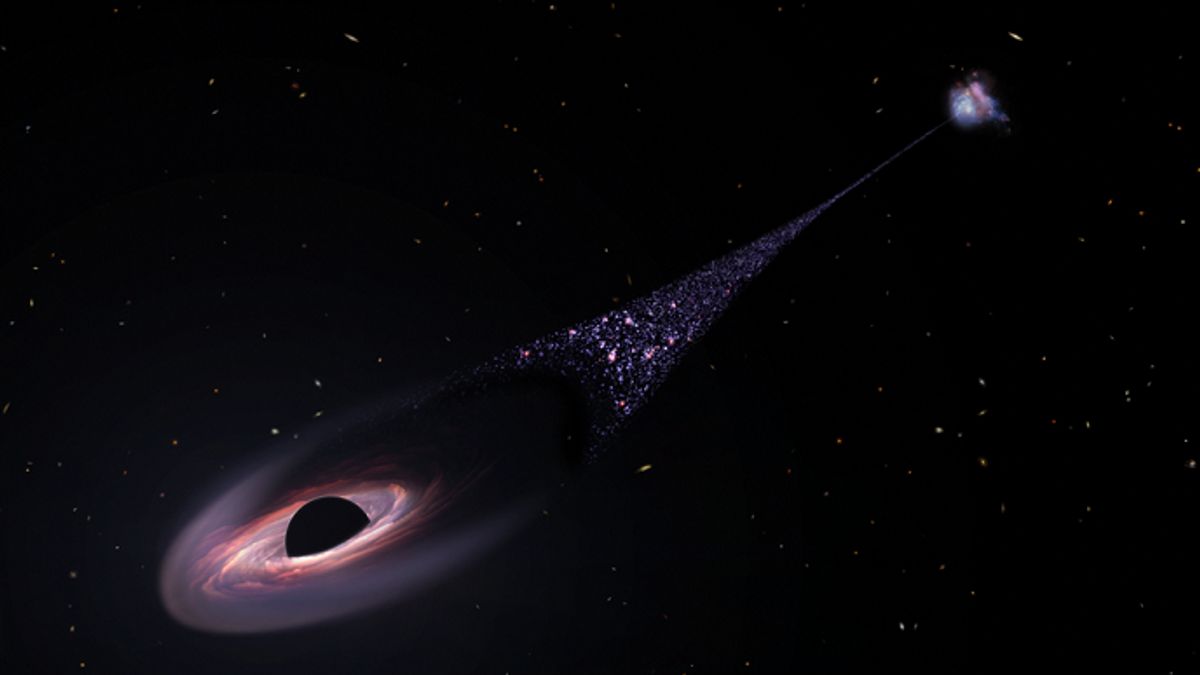JAKARTA - The Hubble Space Telescope accidentally discovered a supermassive black hole speeding through space and creating a trail of stars behind it.
This stunning object weighs the equivalent of 20 million Suns and is believed to have been forcefully ejected from its host galaxy after coming into contact with another supermassive black hole.
The trail of newborn stars is an unprecedented 200 million light-years long, the size of two Milky Way galaxies, half as bright as the host galaxy it links.
"We think we're looking at the wake behind the black hole where gas cools and is able to form stars. So, we're looking at star formation that follows the black hole," said researchers from Yale University in New Haven, Connecticut, United States (US), Pieter van Dokkum.
"What we see is the aftermath. Like waves behind a ship, we see waves behind a black hole."
The black hole is located at one end of the column, which extends back to its parent galaxy. There is a very bright knot of ionized oxygen at the outer end of the column.
Researchers believe the gas may have been shocked and heated from the motion of the black hole hitting the gas, or it could be radiation from the accretion disk around the black hole.
"The gas in front of it was stung by an extremely high-velocity supersonic impact from the black hole moving through the gas. How it works is not known for sure. This is purely coincidental that we encountered," said van Dokkum, in a research paper published on April 6 in The Astrophysical Journal Letters. He then looked for globular star clusters in nearby dwarf galaxies.
"I just scanned through the Hubble Telescope images and then I saw that we have a tiny streak. I immediately thought, cosmic rays hit the camera detector and caused linear imaging artifacts. When we eliminated the cosmic rays, we realized they were still there. It wasn't it looks like nothing we've ever seen before."
Because it was so strange, van Dokkum and his team did follow-up spectroscopy with the WM Keck Observatories in Hawaii. He described the star trails as quite astonishing, very bright, and unusual.
Quoted from the NASA website, Monday, April 10, the researchers concluded that he was looking at the result of a black hole flying through the halo of gas surrounding the parent galaxy.
It is likely the result of multiple supermassive black hole collisions. Researchers suspect the first two galaxies merged perhaps 50 million years ago, which fused two supermassive black holes at their center. They revolve around each other as binary black holes.
Then another galaxy appeared with its own supermassive black hole. The three black holes mixed together lead to a chaotic and unstable configuration.
SEE ALSO:
One of the black holes robbed the momentum of the other two and was ejected from the host galaxy. The original binary may have remained intact, or a new interloper black hole may have replaced one of the two that were in the original binary, kicking off the previous companion.
When one black hole takes off in one direction, the binary black hole shoots up in the opposite direction. There is a visible feature on the opposite side of the host galaxy, possibly an escaped binary black hole. Indirect evidence for this is that there is no sign of an active black hole remaining in the galactic core.
The researchers said the next step was to make follow-up observations with the James Webb Space Telescope and the Chandra X-ray Observatory to confirm the black hole explanation.
Researchers can also use NASA's upcoming Nancy Grace Roman Space Telescope, which is claimed to have a wide-angle view of the universe at the resolution of the Hubble Telescope, which is stunningly beautiful.
As a survey telescope, Roman observers may find more of these rare and improbable star lines elsewhere in the universe. This may require machine learning using algorithms that are really good at finding certain odd shapes in a sea of other astronomical data.
The English, Chinese, Japanese, Arabic, and French versions are automatically generated by the AI. So there may still be inaccuracies in translating, please always see Indonesian as our main language. (system supported by DigitalSiber.id)


















